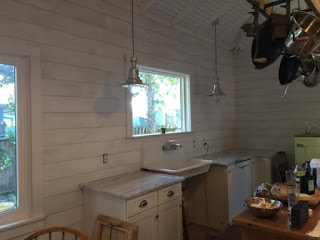This how the hall looked after the original floors were refinished. Notice the variety of colors in the 3" wood strips.
Here I am applying the first layer of conditioner and stain after adding 9' of additional tongue and groove pine to finish the hallway.
Using a pallet to hold my oil paint pigments, I mixed mineral spirits with burnt sienna, yellow ochre, and raw umber to create a variety of stains so that each piece of wood would be a little different like the original. This is the completed floor. It also looks like it is time for a new pair of shorts :0)
Three coats of polyurethane later and the old and the new come together


























